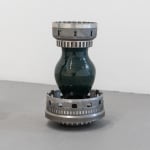Nicolás Lamas
Rotational friction 1, 2022
Metal car parts and ceramic vase
34 x 20 x 20 cm
13 3/8 x 7 7/8 x 7 7/8 inches
13 3/8 x 7 7/8 x 7 7/8 inches
Copyright the artist and Meessen De Clercq
Photo: Dirk Tacke
Weitere Abbildungen
„Rotational friction 1“ (2022) und „Rotational friction 2“ (2023) sind Skulpturen aus mechanischen Autoteilen, die mit gesammelten Gefäßen verbunden sind und in denen Nicolás Lamas Ideen zu Rotation, Reibung und...
„Rotational friction 1“ (2022) und „Rotational friction 2“ (2023) sind Skulpturen aus mechanischen Autoteilen, die mit gesammelten Gefäßen verbunden sind und in denen Nicolás Lamas Ideen zu Rotation, Reibung und Fragilität thematisiert. Ebenso spiegeln sie das Interesse des Künstlers an Archäologie und der Durchdringung von zeitlichen Aspekten wider. Die Werke wirken wie hybride Artefakte, die verschiedene Zeitlinien und wichtige Meilensteine humanen Fortschritts vereinen. „Technologie entwickelt sich weiter und blickt in die Zukunft, während die Archäologie eine Disziplin ist, die per Definition ständig Daten aus der Vergangenheit sammelt, und zwar anhand der materiellen Spuren, die unsere Vorfahren hinterlassen haben. Manchmal vergessen wir jedoch, dass sich sowohl die Vergangenheit als auch die Zukunft ständig weiterentwickeln.“ Der Künstler versucht in seinen Werken starre Konzepte aufzubrechen und bringt Kunst, Wissenschaft, Technologie und Alltagskultur zusammen, indem er aus einem Fundus an gesammelten Gegenständen schöpft. So bilden die collagierten Skulpturen eine neue Sichtweise auf ihre ursprünglichen Kontexte und bieten die Möglichkeit immer neue Schlüsse aus dem Vergangenen zu ziehen, was die Grundlage für die Vorstellung einer möglichen Zukunft bildet.
"Rotational friction 1" (2022) and "Rotational friction 2" (2023) are sculptures made of mechanical car parts connected to collected vessels, in which Nicolás Lamas addresses ideas about rotation, friction and fragility. Likewise, they reflect the artist's interest in archaeology and the interpenetration of temporal aspects. The works act as hybrid artifacts that unite different timelines and important milestones of human progress. "Technology evolves and looks to the future, while archaeology is a discipline that, by definition, constantly collects data from the past through the material traces left by our ancestors. Sometimes, however, we forget that both the past and the future are constantly evolving." The artist seeks to break down rigid concepts in his works, bringing together art, science, technology and everyday culture by drawing from a trove of collected objects. In this way, the collaged sculptures form a new perspective on their original contexts and offer the possibility of always drawing new conclusions from the past, which forms the basis for imagining possible futures.
"Rotational friction 1" (2022) and "Rotational friction 2" (2023) are sculptures made of mechanical car parts connected to collected vessels, in which Nicolás Lamas addresses ideas about rotation, friction and fragility. Likewise, they reflect the artist's interest in archaeology and the interpenetration of temporal aspects. The works act as hybrid artifacts that unite different timelines and important milestones of human progress. "Technology evolves and looks to the future, while archaeology is a discipline that, by definition, constantly collects data from the past through the material traces left by our ancestors. Sometimes, however, we forget that both the past and the future are constantly evolving." The artist seeks to break down rigid concepts in his works, bringing together art, science, technology and everyday culture by drawing from a trove of collected objects. In this way, the collaged sculptures form a new perspective on their original contexts and offer the possibility of always drawing new conclusions from the past, which forms the basis for imagining possible futures.









